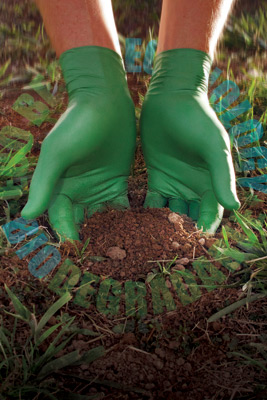Biodegradable Nitrile Glove Briefing
►skip the article and +shop for Sustainable Hand Protection here now
Do you know what happens with your single-use gloves after you have worn and disposed it? Maybe you don’t care but here’s the deal folks, every year 100 billion disposable gloves are thrown away where it takes centuries to fully decompose in landfill. This means the very first nitrile gloves ever produced (including those worn by you) are still out there somewhere.
If you feel guilty about the disposable gloves you’ve trashed you aren’t alone. To tackle the growing volume of waste, eco-conscience glove suppliers are investing heavily in Research & Development (R&D) for sustainable hand protection products with limited environmental impact. 
•What is Biodegradability?
Biodegradable is defined as the ability of things to get disintegrated (decomposed) by the action of micro-organisms such as bacteria or fungi in a way that is not harmful to the environment. When you hear that a glove is biodegradable, it is important to consider whether the glove will achieve a high level of degradability under controlled conditions. How fast will the glove degrade? Under which conditions? Will biodegradability affect the glove’s shelf life or efficiency?
•Changing the Future of Single-Use Gloves
Changing the future of single-use gloves, the inventor of the world's first nitrile gloves, SHOWA®, first launched biodegradable nitrile gloves back in 2012 in response to the overwhelming amount of plastic waste and the growing climate crisis.
Growing in popularity, single-use latex-free biodegradable gloves from SHOWA® are made with the same rigid quality controls and manufacturing standards as conventional nitrile gloves but feature proprietary additives that allow them to quickly breakdown in landfill.
This means the overall performance, protection and durability of the glove stays exactly the same with reduced impact on the environment.
•Same Glove, Better For The Planet
Special additives to nitrile rubber formulations are intended to disrupt the current waste cycle of conventional gloves. These specially treated gloves break down, or biodegrade, in natural elements such as landfill at accelerated rates with zero waste, no toxic residues and will not contaminate ground water. With SHOWA's® impressive portfolio of biodegradable single use gloves, achieving sustainability is in your hands!
To understand how well a biodegradable nitrile glove performs, it is important to know how nitrile biodegradability is tested and measured. It is also important to understand these testing methods to understand competitive claims or “product advantages”.
•ASTM Testing Methods for Biodegradable Claims
To ensure consumers they’re buying sustainable hand protection with verified product claims, there are two accepted and respected methods for testing biodegradability. ASTM D5511 and ASTM D5526 certifications were established to determine the anaerobic biodegradation (the degradation of compounds by microorganisms in the absence of oxygen) of plastics in accelerated landfill conditions. The major difference between the two ASTM International test methods revolves around the length of time and accuracy.
•The Biodegradation Process
So how does biodegradation work? It first starts in the production process where additives to the nitrile glove formulation act as a “food source” to attract microorganisms found within the landfills. When biodegradable gloves are disposed in biologically active landfills, microbes consume, metabolize and break down (or depolymerize) the nitrile materials into three non-toxic, natural compounds – organic soil, methane and carbon dioxide to create healthy soil leaving zero waste behind with no toxic residues.
[ 1 ] Proprietary materials are added to the nitrile during production
[ 2 ] Glove are used and then disposed
[ 3 ] Gloves are transferred and discarded into biologically active landfills
[ 4 ] Microorganisms break down the gloves
[ 5 ] Organic soil and biogas are left in its place
Biodegradable technologies are making a difference to the environment without compromising protection or performance. Thanks to special compositions, sustainable nitrile gloves will decompose within 1 to 5 years in active landfills where conventional nitrile gloves take 200+ years.
Consider the number of disposable gloves consumed every day in our hospitals, offices, restaurants, schools, warehouses, labs and service industries. The numbers are astronomical. With biodegradable gloves, the environmental impact is the only difference. Simply throw these gloves away and let the landfill do the rest!
As your sustainable partner, MDS offers the most extensive selection of validated biodegradable hand protection on the market! All you need to do is tap the link and ….
+shop for Sustainable Hand Protection here now
Monday - Friday 8:30am - 4:30pm Eastern Standard Time
Click or Call
Orders. Questions. Samples. Volume Discounts.
+(800) 274-4637 | +(716) 668-4001 | [email protected] | eco-MDSassociates.com | MDSassociates.com
""We Want You to Return Home Safely Every Day"



